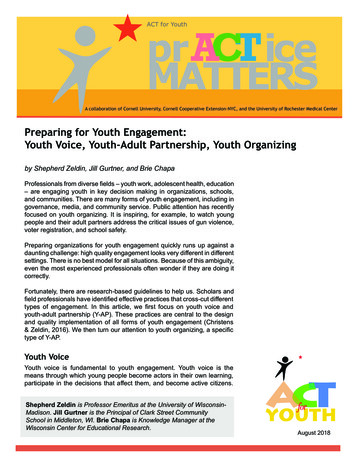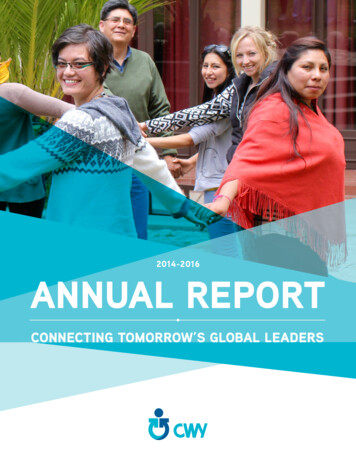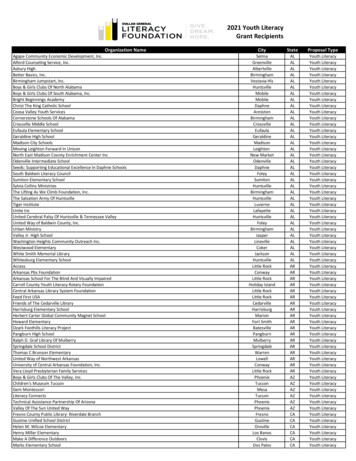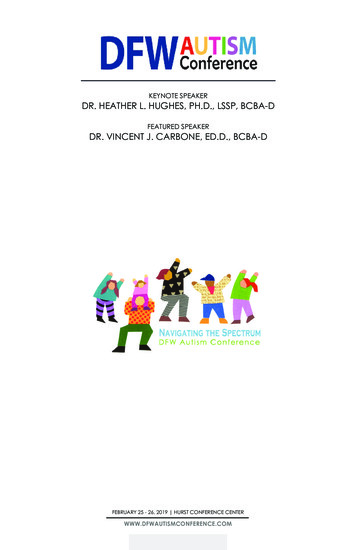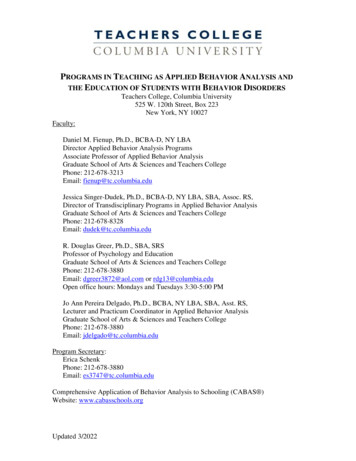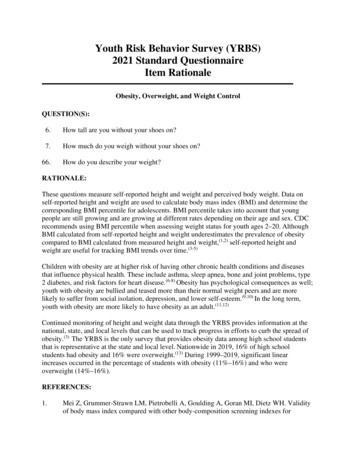
Transcription
Youth Risk Behavior Survey (YRBS)2021 Standard QuestionnaireItem RationaleObesity, Overweight, and Weight ControlQUESTION(S):6.How tall are you without your shoes on?7.How much do you weigh without your shoes on?66.How do you describe your weight?RATIONALE:These questions measure self-reported height and weight and perceived body weight. Data onself-reported height and weight are used to calculate body mass index (BMI) and determine thecorresponding BMI percentile for adolescents. BMI percentile takes into account that youngpeople are still growing and are growing at different rates depending on their age and sex. CDCrecommends using BMI percentile when assessing weight status for youth ages 2–20. AlthoughBMI calculated from self-reported height and weight underestimates the prevalence of obesitycompared to BMI calculated from measured height and weight,(1,2) self-reported height andweight are useful for tracking BMI trends over time.(3-5)Children with obesity are at higher risk of having other chronic health conditions and diseasesthat influence physical health. These include asthma, sleep apnea, bone and joint problems, type2 diabetes, and risk factors for heart disease.(6-8) Obesity has psychological consequences as well;youth with obesity are bullied and teased more than their normal weight peers and are morelikely to suffer from social isolation, depression, and lower self-esteem.(9,10) In the long term,youth with obesity are more likely to have obesity as an adult.(11,12)Continued monitoring of height and weight data through the YRBS provides information at thenational, state, and local levels that can be used to track progress in efforts to curb the spread ofobesity.(3) The YRBS is the only survey that provides obesity data among high school studentsthat is representative at the state and local level. Nationwide in 2019, 16% of high schoolstudents had obesity and 16% were overweight.(13) During 1999–2019, significant linearincreases occurred in the percentage of students with obesity (11%–16%) and who wereoverweight (14%–16%).REFERENCES:1.Mei Z, Grummer-Strawn LM, Pietrobelli A, Goulding A, Goran MI, Dietz WH. Validityof body mass index compared with other body-composition screening indexes for
Item Rationale for the 2021 Standard High School YRBSassessment of body fatness in children and adolescents. American Journal of ClinicalNutrition 2002;75(6):978–985.2.Jayawardene W, Lohrmann D, YoussefAgha A. Discrepant body mass index: behaviorsassociated with height and weight misreporting among US adolescents from the NationalYouth Physical Activity and Nutrition Study. Childhood Obesity 2014;10(3).3.Krebs NF, Himes JH, Jacobson D, Nicklas TA, Guilday P, Styne D. Assessment of childand adolescent overweight and obesity. Pediatrics 2007;120:S193–S228.4.Institute of Medicine. Evaluating Obesity Prevention Efforts: A Plan for MeasuringProgress. Washington, DC: The National Academies Press; 2013.5.Brener ND, McManus T, Galuska DA, Lowry R, Wechsler H. Reliability and validity ofself-reported height and weight among high school students. Journal of AdolescentHealth 2003;32:281–287.6.May AL, Kuklina EV, Yoon PW. Prevalence of cardiovascular disease risk factorsamong US adolescents, 1999 2008. Pediatrics 2012;129(6):1035–1041.7.Lloyd LJ, Langley-Evans SC, McMullen S. Childhood obesity and risk of the adultmetabolic syndrome: a systematic review. International Journal of Obesity 2012;36(1):1–11.8.Haflon NH, Larson K, Slusser W. Associations between obesity and comorbid mentalhealth, developmental and physical health conditions in a nationally representativesample of US children aged 10 to 17. Academic Pediatrics 2013; 13(1):6-13.9.Van Geel M, Vedder P, Tanilon J. Are overweight and obese youths more often bulliedby their peers? A meta-analysis on the correlation between weight status and bullying.International Journal of Obesity 2014;38(10):1263–1267.10.Griffiths LI, Parsons TJ, Hill AJ. Self-esteem and quality of life in obese children andadolescents: a systematic review. International Journal of Pediatric Obesity2010;5(4):282–304.11.The NS, Suchindran C, North KE, Popkin BM, Gordon-Larsen P. Association ofadolescent obesity with risk of severe obesity in adulthood. Journal of the AmericanMedical Association 2010;304(18):2042-2047.12.Singh AS, Mulder C, Twisk JWR, Van Mechelen V, Chinapaw MJM. Tracking ofchildhood overweight into adulthood: a systematic review of the literature. ObesityReviews 2008;9(5):474–488.13.Centers for Disease Control and Prevention (CDC). 1991-2019 High School Youth RiskBehavior Survey Data. Available at https://yrbs-explorer.services.cdc.gov/.2
Item Rationale for the 2021 Standard High School YRBSQUESTION(S):67.Which of the following are you trying to do about your weight?RATIONALE:This question measures weight goals. The prevention of childhood obesity involves maintaininga healthy weight while protecting overall health, growth and development, and nutritionalstatus.(1) The Expert Committee Recommendations Regarding the Prevention, Assessment, andTreatment of Child and Adolescent Overweight and Obesity recommend that overweightadolescents (85th percentile BMI 95th percentile) achieve a healthy weight by maintainingtheir current weight while stature increases; adolescents with obesity (BMI 95th percentile) canpursue weight loss that is not to exceed an average of 2 pounds per week.(2) The goals of obesityprevention in children and adolescents also include the avoidance of potentially harmful weightconcern and restrictive eating behaviors.(3) For these reasons, understanding adolescents’ weightgoals, both independently and relative to weight status, is of public health importance.(2)Nationwide in 2019, 48% of high school students were trying to lose weight. The percentage ofstudents who were trying to lose weight increased significantly during 1991–2019 (42%–48%).(4)REFERENCES:1.Institute of Medicine. Accelerating Progress in Obesity Prevention: Solving the Weight ofthe Nation. Washington, DC: The National Academies Press; 2012. Available r BA, Barlow SE, Ervin C, et al. Recommendations for treatment of child andadolescent overweight and obesity. Pediatrics 2007;120:S254.3.Golden NH, Schneider M, Wood C, Committee on Nutrition, Committee onAdolescence, Section on Obesity. Preventing obesity and eating disorders in adolescents.Pediatrics Sep 2016, 138 (3) e20161649; DOI: 10.1542/peds.2016-1649.4.Centers for Disease Control and Prevention (CDC). 1991-2019 High School Youth RiskBehavior Survey Data. Available at https://yrbs-explorer.services.cdc.gov/.3
Item Rationale for the 2021 Standard High School YRBSBehaviors that Result in Unintentional InjuriesQUESTION(S):8.How often do you wear a seat belt when riding in a car driven by someone else?RATIONALE:This question measures the frequency with which seat belts are worn when riding in a car drivenby someone else. Motor vehicle crashes are the second leading cause of death among adolescentsaged 13–19 years in the United States.(1) In 2018, 2,486 adolescents (aged 13–19 years) werekilled and approximately 285,000 were treated in emergency departments for motor vehiclecrash-related injuries.(1) When used correctly, seat belts reduce the risk of death and seriousinjury in crashes for passenger car occupants by about half.(2,3) However, in 2018, among allfatally injured 13- to 19-year-old occupants, seat belt use among passengers (36%) wasconsiderably lower than among drivers (48%).(4) In 2019, approximately 43% of high schoolstudents nationwide did not always wear a seat belt when riding in a car driven by someoneelse.(5)REFERENCES:1.CDC/National Center for Injury Prevention and Control (NCIPC). Web-based InjuryStatistics Query and Reporting System (WISQARS). Atlanta, GA: US Department ofHealth and Human Services, CDC; 2020. ane CJ. Lives Saved by Vehicle Safety Technologies and Associated Federal MotorVehicle Safety Standards, 1960 to 2012—Passenger Cars and LTVs—With Reviews of26 FMVSS and the Effectiveness of Their Associated Safety Technologies in ReducingFatalities, Injuries, and Crashes. Washington, DC: National Highway Traffic SafetyAdministration; 2015. Report no. DOT HS 812 ewPublication/8120693.Kahane CJ. Fatality Reduction by Seat Belts in the Center Rear Seat and Comparison ofOccupants’ Relative Fatality Risk at Various Seating Positions. Washington, DC:National Highway Traffic Safety Administration; 2017. Report no. DOT HS 812 ewPublication/8123694.Insurance Institute for Highway Safety (IIHS). Fatality Facts 2018: Teenagers. Arlington,VA: IIHS, Highway Loss Data Institute; 2019. ail/teenagers5.Yellman MA, Bryan L, Sauber-Schatz EK, Brener N. Transportation risk behaviorsamong high school students—Youth Risk Behavior Survey, United States, 2019. MMWRSuppl 2020;69(No. Suppl 1).4
Item Rationale for the 2021 Standard High School YRBSQUESTION(S):9.During the past 30 days, how many times did you ride in a car or other vehicle driven bysomeone who had been drinking alcohol?10.During the past 30 days, how many times did you drive a car or other vehicle when youhad been drinking alcohol?RATIONALE:These questions measure the frequency with which high school students drove a motor vehicleafter drinking alcohol or rode as a passenger in a motor vehicle operated by someone who hadbeen drinking alcohol. In 2017, 19% of 15- to 20-year-old drivers who were involved in fatalmotor vehicle crashes had been drinking alcohol.(1) Among those young drivers who wereinvolved in fatal motor vehicle crashes and had been drinking alcohol, 81% had a blood alcoholconcentration (BAC) equal to or above the legal threshold for adults (which is 0.08% in all statesbut Utah).(1) In 2018, approximately one-fifth of drivers 16–19 years of age who were killed inmotor vehicle crashes had BACs at or above 0.08%.(2) Even at BACs of 0.050%–0.079%, drivers16–20 years of age are about 6 times as likely to be involved in a fatal crash as their sobercounterparts.(3) In 2019, among the approximately 60% of U.S. high school students who haddriven a car or other vehicle during the 30 days before the survey, 5% drove one or more timeswhen they had been drinking alcohol.(4) During 2013–2019, among U.S. high school studentswho had driven a car or other vehicle during the 30 days before the survey, the prevalence ofstudents who had driven one or more times when they had been drinking alcohol decreased from10% to 5%.(5)Riding with a driver of any age who has been drinking alcohol is dangerous. Riding with adrinking driver is also associated with adolescent drinking and driving.(4,6) In addition,longitudinal research indicates that adolescents who ride with impaired drivers at a young age aremore likely to drive while impaired themselves as they get older and start driving.(4,7) In 2019,among high school students nationwide, 17% had ridden in a car or other vehicle driven bysomeone who had been drinking alcohol at least once during the 30 days before the survey.(4)Among students nationwide, the prevalence of riding with a driver who had been drinkingalcohol decreased during 1991–2009 (40%‒28%) and then further decreased during nal Center for Statistics and Analysis (NCSA). Young Drivers: 2017 Data.Traffic Safety Facts Research Note. Washington, DC: National Highway Traffic SafetyAdministration; 2019. Report no. DOT HS 812 ewPublication/812753.5
Item Rationale for the 2021 Standard High School YRBS2.Insurance Institute for Highway Safety (IIHS). Fatality Facts 2018: Teenagers. Arlington,VA: IIHS, Highway Loss Data Institute; 2019. ail/teenagers.3.Voas RB, Torres P, Romano E, Lacey JH. Alcohol-related risk of driver fatalities: anupdate using 2007 data. J Stud Alcohol Drugs llman MA, Bryan L, Sauber-Schatz EK, Brener N. Transportation risk behaviorsamong high school students—Youth Risk Behavior Survey, United States, 2019. MMWRSuppl 2020;69(No. Suppl 1).5.Centers for Disease Control and Prevention (CDC). 1991-2019 High School Youth RiskBehavior Survey Data. Available at er BJ, Foran K, Grove-White A. How much can you drink before driving? Theinfluence of riding with impaired adults and peers on the driving behaviors of urban andrural youth. Addiction 2008;103:629–37. doi:10.1111/j.1360-0443.2008.02139.x7.Li K, Simons-Morton BG, Vaca FE, Hingson R. Association between riding with animpaired driver and driving while impaired. Pediatrics ON(S):11.During the past 30 days, on how many days did you text or e-mail while driving a car orother vehicle?RATIONALE:This question measures the frequency with which students engage in texting or e-mailing whiledriving a motor vehicle. Motor vehicle crashes are the second leading cause of death among U.S.adolescents aged 13–19.(1) Drivers aged 15–19 are overrepresented in distraction-affected fatalcrashes and distraction-affected fatal crashes that involve cell phone use.(2) In 2018, 8% of alldrivers aged 15–19 involved in fatal crashes were reported as distracted at the time of the crash,and 17% of these distracted teens were distracted by the use of cell phones.(2) The performanceof distracting secondary tasks while driving, such as texting while driving, significantly increasesrisk for a crash or near-crash among novice, inexperienced drivers.(3,4) Texting while driving isan especially risky type of distracted driving, as it involves three types of driver distraction:visual, physical/manual, and cognitive.(5) Teen drivers are more vulnerable to the effects ofdistraction(3,6,7) and are less able to disengage from distracting behaviors as road hazards emergethan adults.(8) In 2019, among the approximately 60% of high school students nationwide whohad driven a car or other vehicle during the 30 days before the survey, the prevalence of textingwhile driving one or more times in the 30 days before the survey was 39%.(9) The prevalence of6
Item Rationale for the 2021 Standard High School YRBStexting while driving among high school students who had driven a car or other vehicle duringthe 30 days before the survey has not changed significantly since this question was first includedin the Youth Risk Behavior Surveillance System questionnaires in 2013.(10)REFERENCES:1.CDC/National Center for Injury Prevention and Control (NCIPC). Web-based InjuryStatistics Query and Reporting System (WISQARS). Atlanta, GA: US Department ofHealth and Human Services, CDC; 2020. TSA/National Center for Statistics and Analysis (NCSA). Distracted Driving 2018.Traffic Safety Facts Research Note. Washington, DC: National Highway Traffic SafetyAdministration; 2020. Report no. DOT HS 812 blication/812926.3.Klauer SG, Guo F, Simons-Morton BG, Ouimet MC, Lee S, Dingus TA. Distracteddriving and risk of road crashes among novice and experienced drivers. N Engl J Med2014;370(1):54–9. doi:10.1056/nejmsa12041424.Simons-Morton BG, Klauer SG, Ouimet MC, et al. Naturalistic Teenage Driving Study:findings and lessons learned. J Safety Res. 2015;54:41–44. doi:10.1016/j.jsr.2015.06.0105.Caird JK, Johnston KA, Willness CR, Asbridge M, Steel P. A meta-analysis of the effectsof texting on driving. Accid Anal Prev 2014;71:311–18. doi:10.1016/j.aap.2014.06.0056.Alderman EM, Johnston BD; Committee on Adolescence; Council on Injury, Violence,and Poison Prevention. The teen driver. Pediatrics. Llerena LE, Aronow KV, Macleod J, et al. An evidence-based review: distracted driver. JTrauma Acute Care Surg 2015;78:147–52. doi:10.1097/TA.00000000000004878.Lee SE, Klauer SG, Olsen ECB, et al. Detection of road hazards by novice teen andexperienced adult drivers. Transportation Research Record 2008;2078:26–32.9.Yellman MA, Bryan L, Sauber-Schatz EK, Brener N. Transportation risk behaviorsamong high school students—Youth Risk Behavior Survey, United States, 2019. MMWRSuppl 2020;69(No. Suppl 1).10.Centers for Disease Control and Prevention (CDC). 1991-2019 High School Youth RiskBehavior Survey Data. Available at https://yrbs-explorer.services.cdc.gov/.7
Item Rationale for the 2021 Standard High School YRBSBehaviors that Result in ViolenceQUESTION(S):12.During the past 30 days, on how many days did you carry a weapon such as a gun, knife,or club on school property?13.During the past 12 months, on how many days did you carry a gun? (Do not count thedays when you carried a gun only for hunting or for a sport, such as target shooting.)14.During the past 30 days, on how many days did you not go to school because you felt youwould be unsafe at school or on your way to or from school?15.During the past 12 months, how many times has someone threatened or injured you witha weapon such as a gun, knife, or club on school property?RATIONALE:These questions measure violence-related behaviors and school-related violent behaviors.Violence is a significant public health issue among youth, with homicide being the third leadingcause of death among youth ages 13 –19 years (6.3 per 100,000).(1) Homicide is the leadingcause of death among non-Hispanic black youth ages 13–19 years (25.6 per 100,000) and thethird leading cause of death for Hispanic youth ages 13–19 years (5.2 per 100,000).(1)Approximately 10% of homicide victims in the United States in 2018 were aged 13–19 years; ofthese victims, 90% were killed with a firearm.(1) Of all violent deaths that occurred on schoolproperty among youth aged 13-19 years between July 1994 and June 2018, 71% involvedfirearms.(2) Nearly 100% of school districts have a policy prohibiting weapon possession or useby high school students on school property.(3) Also, in 2018, almost 170,000 (577.4 per 100,000)nonfatal, physical assault injuries among youth aged 13–19 years were treated in U.S. emergencydepartments.(1)Among high school students nationwide in 2019, 13% had carried a weapon and 3% had carrieda weapon on school property on at least 1 day during the 30 days before the survey.(4) Theprevalence of having carried a weapon decreased significantly 1991–2019 (26%–13%).(4) Theprevalence of having carried a weapon on school property decreased during 1993–1997 (12%–9%) and then decreased more slowly during 1997–2019 (9%–3%).(4) For the first time in 2017,the question assessing prevalence of having carried a gun during the 12 months before the surveyinstructed respondents not to count the days when they carried a gun only for hunting or for asport, such as target shooting. In 2019, 4% of high school students carried a gun (not countingthe days when they carried a gun only for hunting or for a sport, such as target shooting) duringthe 12 months before the survey, decreasing slightly from 5% in 2017.(4)Among high school students nationwide in 2019, 9% had not gone to school on at least 1 dayduring the 30 days before the survey because they felt they would be unsafe at school or on theirway to or from school and 7% had been threatened or injured with a weapon on school property8
Item Rationale for the 2021 Standard High School YRBSone or more times during the 12 months before the survey.(4) Among students nationwide, theprevalence of having not gone to school because of safety concerns increased significantlyduring 1993–2019 (4%–9%).(4) Among students nationwide, the prevalence of having beenthreatened or injured with a weapon on school property did not change significantly during1993–2003 (7%–9%) and then decreased during 2003–2019 (9%–7%).(4)REFERENCES:1.Web-based Injury Statistics Query and Reporting System (WISQARS) [database online].Atlanta, GA: Centers for Disease Control and Prevention, National Center for InjuryPrevention and Control; 2020.2.School-Associated Violent Death Surveillance System (SAVD-SS). Atlanta, GA: Centersfor Disease Control and Prevention, National Center for Injury Prevention and Control;2018.3.Jones SE, Fisher CJ, Greene BZ, Hertz MF, Pritzl J. Healthy and safe schoolenvironment, part I: Results from the School Health Policies and Programs Study 2006.Journal of School Health 2007;77(8):522–543.4.Centers for Disease Control and Prevention (CDC). 1991-2019 High School Youth RiskBehavior Survey Data. Available at ):16.During the past 12 months, how many times were you in a physical fight?17.During the past 12 months, how many times were you in a physical fight on schoolproperty?RATIONALE:These questions measure the frequency of physical fights in general and on school propertyduring the 12 months before the survey. Physical fighting is a marker for other problembehaviors (1) and is associated with serious injury-related health outcomes.(2,3) Among highschool students nationwide in 2019, 22% had been in a physical fight and 8% had been in aphysical fight on school property one or more times during the 12 months before the survey.(4)The percentage of high school students who were in a physical fight decreased during 1991–2011 (43%–33%) and then decreased further during 2011–2019 (33%-22%).(4) The percentage ofhigh school students who were in a physical fight on school property also decreased significantlyduring 1993–2019 (16%–8%).(4)9
Item Rationale for the 2021 Standard High School YRBSREFERENCES:1.Sosin DM, Koepsell TD, Rivara FP, Mercy JA. Fighting as a marker for multipleproblem behaviors in adolescents. Journal of Adolescent Health 1995;16:209–215.2.Borowsky IW, Ireland M. Predictors of future fight-related injury among adolescents.Pediatrics 2004;113:530–536.3.Pickett W, Craig W, Harel Y, et al. Cross-national study of fighting and weapon carryingas determinants of adolescent injury. Pediatrics 2005;116:855–863.4.Centers for Disease Control and Prevention (CDC). 1991-2019 High School Youth RiskBehavior Survey Data. Available at ):18.Have you ever seen someone get physically attacked, beaten, stabbed, or shot in yourneighborhood?RATIONALE:Witnessing neighborhood violence has not been measured by the YRBS before, but data from a2015 Monroe County survey found that 19% of students had seen someone shot, stabbed, orbeaten in their community.(1) In addition, data from a 2009 survey of New York State adultresidents found that 25% of adults sampled indicated they were exposed to violence in theircommunity before age 18.(2) The World Health Organization considers exposure to communityviolence to be an adverse childhood experience.(3) Measuring exposure to community violence isimportant because adverse childhood experiences are a focus area of CDC, and this measureseeks to capture the community context for violence.REFERENCES:1.ACEs Connection. Trauma Informed Schools. Available 0751300/Paper%20Tigers%20Data%20Slides.pdf.2.Lee E, Larkin H, saki N. Exposure to community violence as a new adverse childhoodexperience category: Promising results and future considerations. Families in Society2017;98(1):69–78.3.World Health Organization (WHO). Adverse Childhood Experiences InternationalQuestionnaire. In Adverse Childhood Experiences International Questionnaire (ACE-IQ):Geneva: WHO, 2018. Available at10
Item Rationale for the 2021 Standard High School YRBShttps://www.who.int/violence injury prevention/violence/activities/adverse childhood experiences/en/.QUESTION(S):19.Have you ever been physically forced to have sexual intercourse when you did not wantto?20.During the past 12 months, how many times did anyone force you to do sexual things thatyou did not want to do? (Count such things as kissing, touching, or being physicallyforced to have sexual intercourse.)21.During the past 12 months, how many times did someone you were dating or going outwith force you to do sexual things that you did not want to do? (Count such things askissing, touching, or being physically forced to have sexual intercourse.)22.During the past 12 months, how many times did someone you were dating or going outwith physically hurt you on purpose? (Count such things as being hit, slammed intosomething, or injured with an object or weapon.)RATIONALE:These questions measure the frequency of sexual violence and dating violence experienced bystudents. Sexual and dating violence victimization are associated with a range of negativeconsequences including suicide ideation and attempts, major depressive episodes, increasedalcohol, tobacco, and other substance use, eating disorders, and risky sexual behavior.(1-6)According to the Centers for Disease Control and Prevention’s National Intimate Partner andSexual Violence Survey, 1 in 5 U.S. women have experienced (completed or attempted) rape and1 in 14 U.S. men have been made to sexually penetrate someone else (completed or attempted) intheir lifetime; among female victims of rape, 43.2% were under 18 years old at the time of theirfirst victimization, and among male victims of being made to penetrate, 25.9% were under 18 atthe time of the first victimization.(7) About 1 in 4 women (23.2%) and 1 in 7 men (13.9%) haveexperienced severe physical violence by an intimate partner (e.g., hit with a fist or somethinghard, beaten, slammed against something) at some point in their lifetime.(8) Among adults whoever experienced contact sexual violence, physical violence, and/or stalking by an intimatepartner, 25.6% of women and 14.4% of men first experienced some form of violence by thatpartner between 11 and 17 years of age.(8)All three sexual violence questions are important for understanding the public health burden ofsexual violence against young people, guiding prevention strategies, and monitoring changesover time. These data are particularly useful for monitoring changes in trends and the effects ofprevention efforts such as CDC’s Rape Prevention Education Program.(9) Data on forced sexualactivity by any perpetrator — not just a dating partner — provides a better understanding of theburden of sexual violence among high school students because studies have shown that11
Item Rationale for the 2021 Standard High School YRBSperpetrators can include current or former friends, acquaintances, family members, and otheradults.(7,10) Preventing sexual violence by any perpetrator and dating violence are focus areas forCDC because they are types of adverse childhood experiences. Knowing the proportion of highschool students who are sexually and physically victimized by a dating partner is also crucialbecause it provides a more complete measure of teen dating violence and prevention strategiesoften focus specifically on violence in dating relationships. These estimates are criticallyimportant for monitoring progress in this area.In 2019, 7% of high school students nationwide had ever been physically forced to have sexualintercourse when they did not want to.(11) The percentage of high school students who had everbeen physically forced to have sexual intercourse when they did not want to decreasedsignificantly during 2001–2019 (8%–7%).(11) Among the students who dated or went out withsomeone during the 12 months before the survey, 8% experienced physical dating violence by adating partner, and 8% experienced sexual dating violence by a dating partner.(12) The percentageof high school students who experienced physical dating violence and sexual dating violenceboth decreased significantly during 2013–2019 (10%–8%).(11) Nationwide, 11% of studentsexperienced sexual violence by anyone one or more times during the 12 months before thesurvey.(12)REFERENCES:1.Basile KC, Clayton HB, Leemis RW, Rostad W. Sexual violence victimization of youthand health risk behaviors. American Journal of Preventive Medicine e.2019.11.0202.Ackard DM, Eisenberg ME, Neumark-Sztainer D. Long-term impact of adolescent datingviolence on the behavioral and psychological health of male and female youth. Journal ofPediatrics 2007;151(5):476–481.3.Vagi K, Olson E, Basile KC, Vivolo-Kantor A. Teen dating violence (physical andsexual) among US high school students: findings from the 2013 National Youth RiskBehavior Survey. JAMA Pediatrics 2015;169(5):474-482.4.Young A, Grey M, Boyd CJ, McCabe SE. Adolescent sexual assault and the medical andnonmedical use of prescription medication. J Addict Nurs. 2011;11(1 38.5.Wolitzy-Taylor KB, Ruggiero JK, Danielson CK, et al. Prevalence and correlates ofdating violence in a national sample of adolescents. Journal of the American Academy ofChild and Adolescent Psychiatry 2008;47(7):755–762.6.Lormand DK, Markham CM, Peskin MF, et al. Dating violence among urban, minority,middle school youth and associated sexual risk behaviors and substance use. Journal ofSchool Health 2013;83(6):415–421.12
Item Rationale for the 2021 Standard High School YRBS7.Smith SG, Zhang, X., Basile, K.C., et al. National Intimate Partner and Sexual ViolenceSurvey: 2015 Data Brief. Atlanta, GA: National Center for Injury Prevention andControl, Centers for Disease Control and Prevention; 2018.8.Smith SG, Chen J, Basile KC, et al. The National Intimate Partner and Sexual ViolenceSurvey (NISVS): 2010-2012 State Report. Atlanta, GA: National Center for InjuryPrevention and Control, Centers for Disease Control and Prevention; 2017.9.Centers for Disease Control and
(1) Among those young drivers who were involved in fatal motor vehicle crashes and had been drinking alcohol, 81% had a blood alcohol concentration (BAC) equal to or above the legal threshold for adults (which is 0.08% in all states but Utah).(1) In 2018, approximately one-fifth of drivers 16-19 years of age who were killed in



